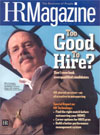Top Trends Facing HR
HR professionals have identified a number of important issues that will have an impact on the profession.
 This past summer the Society for Human Resource Management (SHRM) released the results of its latest biennial survey on the most important trends affecting the human resource profession. The SHRM 2004-2005 Workplace Forecast: A Strategic Outlook reports HR professionals’ views on the developments they think will have the biggest impact on the workplace in the coming decade.
This past summer the Society for Human Resource Management (SHRM) released the results of its latest biennial survey on the most important trends affecting the human resource profession. The SHRM 2004-2005 Workplace Forecast: A Strategic Outlook reports HR professionals’ views on the developments they think will have the biggest impact on the workplace in the coming decade.
The most critical concern among HR professionals is the rising cost of providing health care coverage for employees. In fact, it is seen not just as a workplace issue but also as a threat to U.S. competitiveness.
Another key issue is the use of technology—particularly how it can help HR improve communications with employees, but also how it will continue to be used in transactional HR functions.
The development and use of electronic learning is also seen as a major area of potential change as individuals both in and outside the workplace increasingly gain access to online education.
Safety and security issues also appear high on the list of important trends. HR practitioners often look to broader international and political developments when they identify the trends that have the biggest impact on the safety of their workers.
Finally, the effects of demographic trends on employment and the labor market stand out as a topic that HR professionals think about a great deal. Some are concerned mainly about preparing for a potential labor or skills shortage as baby boomers leave the workplace, while others are focused on the effects of global demographic changes.
The survey highlights HR professionals’ actions in response to these familiar trends and how these changes may be influencing the HR profession itself. For example, the majority of the HR professionals surveyed said that to address demographic changes, and particularly a potential skills shortage, their companies have been investing more in training and development, and putting more emphasis on succession planning. Many companies are even bringing retirees back into the workforce and are training line managers to recognize and respond to generational differences.
Putting such programs in place today, even in a relatively slack jobs market, shows how beliefs about future demographic changes are already affecting today’s business practices.
It will be crucial for HR managers to closely examine and sometimes question their own beliefs about key trends and the future of work. Those involved in strategic planning must come up with several scenarios of what the future may hold for their business, and not only plan ahead but also remain flexible enough to respond quickly to the unexpected.
For more information on emerging issues or for free access (SHRM members only) to the SHRM 2004-2005 Workplace Forecast: A Strategic Outlook, visit www.shrm.org/trends. The report can be purchased—$79.95 for members, $99.95 for nonmembers—from the SHRM bookstore at www.shrm.org/shrmstore or by calling 1-800-444-5006.
Jennifer Schramm is manager of the Workplace Trends and Forecasting program at SHRM.
Advertisement
An organization run by AI is not a futuristic concept. Such technology is already a part of many workplaces and will continue to shape the labor market and HR. Here's how employers and employees can successfully manage generative AI and other AI-powered systems.
Advertisement


